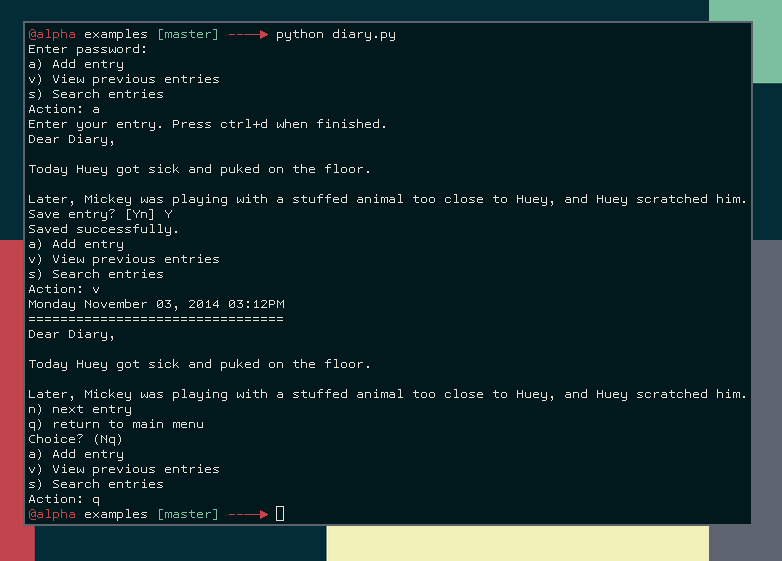Search: "sqlite AND peewee"
Going Fast with SQLite and Python
In this post I'd like to share with you some techniques for effectively working with SQLite using Python. SQLite is a capable library, providing an in-process relational database for efficient storage of small-to-medium-sized data sets. It supports most of the common features of SQL with few exceptions. Best of all, most Python users do not need to install anything to get started working with SQLite, as the standard library in most distributions ships with the sqlite3 module.
Meet Scout, a Search Server Powered by SQLite
In my continuing adventures with SQLite, I had the idea of writing a RESTful search server utilizing SQLite's full-text search extension. You might think of it as a poor man's ElasticSearch.
So what is this project? Well, the idea I had was that instead of building out separate search implementations for my various projects, I would build a single lightweight search service I could use everywhere. I really like SQLite (and have previously blogged about using SQLite's full-text search with Python), and the full-text search extension is quite good, so it didn't require much imagination to take the next leap and expose it as a web-service.
Read on for more details.
SQLite Table-Valued Functions with Python
One of the benefits of running an embedded database like SQLite is that you can configure SQLite to call into your application's code. SQLite provides APIs that allow you to create your own scalar functions, aggregate functions, collations, and even your own virtual tables. In this post I'll describe how I used the virtual table APIs to expose a nice API for creating table-valued (or, multi-value) functions in Python. The project is called sqlite-vtfunc and is hosted on GitHub. If you use Peewee, an equivalent implementation is included in the Peewee SQLite extensions.
Peewee, a lightweight Python ORM - Original Post
For the past month or so I've been working on writing my own ORM in Python. The project grew out of a need for a lightweight persistence layer for use in Flask web apps. As I've grown so familiar with the Django ORM over the past year, many of the ideas in Peewee are analagous to the concepts in Django. My goal from the beginning has been to keep the implementation simple without sacrificing functionality, and to ultimately create something hackable that others might be able to read and contribute to.
Optimistic locking in Peewee ORM
In this post I'll share a simple code snippet you can use to perform optimistic locking when updating model instances. I've intentionally avoided providing an implementation for this in peewee, because I don't believe it will be easy to find a one-size-fits-all approach to versioning and conflict resolution. I've updated the documentation to include the sample implementation provided here, however.
Querying the top N objects per group with Peewee ORM
This post is a follow-up to my post about querying the top related item by group. In this post we'll go over ways to retrieve the top N related objects by group using the Peewee ORM. I've also presented the SQL and the underlying ideas behind the queries, so you can translate them to whatever ORM / query layer you are using.
Retrieving the top N per group is a pretty common task, for example:
- Display my followers and their 10 most recent tweets.
- In each of my inboxes, list the 5 most recent unread messages.
- List the sections of the news site and the three latest stories in each.
- List the five best sales in each department.
In this post we'll discuss the following types of solutions:
- Solutions involving
COUNT() - Solutions involving
LIMIT - Window functions
- Postgresql lateral joins
Querying the top item by group with peewee ORM
In this post I'd like to share some techniques for querying the top item by group using the Peewee ORM. For example,
- List the most recent tweet by each of my followers.
- List the highest severity open bug for each of my open source projects.
- List the latest story in each section of a news site.
This is a common task, but one that can be a little tricky to implement in a single SQL query. To add a twist, we won't use window functions or other special SQL constructs, since they aren't supported by SQLite. If you're interested in finding the top N items per group, check out this follow-up post.
Dear Diary, an Encrypted Command-Line Diary with Python
In my last post, I wrote about how to work with encrypted SQLite databases with Python. As an example application of these libraries, I showed some code fragments for a fictional diary program. Because I was thinking the examples directory of the peewee repo was looking a little thin, I decided to flesh out the diary program and include it as an example.
In this post, I'll go over the diary code in the hopes that you may find it interesting or useful. The code shows how to use the peewee SQLCipher extension. I've also implemented a simple command-line menu loop. All told, the code is less than 100 lines!
LSM Key/Value Storage in SQLite3
Several months ago I was delighted to see a new extension appear in the SQLite source tree. The lsm1 extension is based on the LSM key/value database developed as an experimental storage engine for the now-defunct SQLite4 project. Since development has stopped on SQLite4 for the forseeable future, I was happy to see this technology being folded into SQLite3 and was curious to see what the SQLite developers had in mind for this library.
The SQLite4 LSM captured my interest several years ago as it seemed like a viable alternative to some of the other embedded key/value databases floating around (LevelDB, BerkeleyDB, etc), and I went so far as to write a set of Python bindings for the library. As a storage engine, it seems to offer stable performance, with fast reads of key ranges and fast-ish writes, though random reads may be slower than the usual SQLite3 btree. Like SQLite3, the LSM database supports a single-writer/multiple-reader transactional concurrency model, as well as nested transaction support.
The LSM implementation in SQLite3 is essentially the same as that in SQLite4, plus some additional bugfixes and performance improvements. Crucially, the SQLite3 implementation comes with a standalone extension that exposes the storage engine as a virtual table. The rest of this post will deal with the virtual table, its implementation, and how to use it.
Misadventures in Python Packaging: Optional C Extensions
I began an unlikely adventure into Python packaging this week when I made what
I thought were some innocuous modifications to the source distribution and
setup.py script for the peewee
database library. Over the course of a day, the setup.py more than doubled in
size and underwent five major revisions as I worked to fix problems arising out
of various differences in users environments. This was tracked in issue #1676,
may it always bear witness to the complexities of Python packaging!
In this post I'll explain what happened, the various things I tried, and how I ended up resolving the issue.






